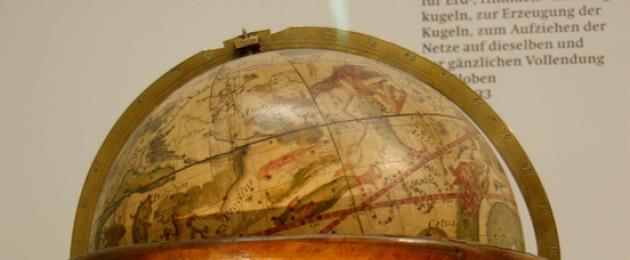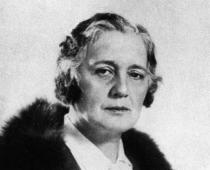In the works of ancient writers, it is mentioned that a certain Crates of Malos, an ancient Greek philosopher, a follower of Aristotle and the keeper of the Pergamon Library, back in the 2nd century BC. e. made a model of the Earth in the form of a sphere. Neither this model itself, nor any of its images have survived to this day, however, those who saw this globe said that "Crates painted a single land on the ball, dividing it into parts by intersecting rivers, which were called oceans ...".
Therefore, the very first, at least the oldest of all surviving globes, is considered to be a spherical model of the Earth with a diameter of 54 cm, created by a German geographer, traveler and mathematician Martin Beheim in 1492, which is now in the Museum of the city of Nuremberg.
On the "Earth Apple", this is how Behaim called his brainchild (globes, from the Latin globus - "ball", copies of the Earth began to be called later), geographical representations of the Earth's surface on the eve of the discovery of the New World, based on data taken from world maps the ancient Greek scientist Ptolemy, who lived in the II century.
Soon after the appearance of the globes, which give the most accurate cartographic representations and are in great demand among scientists and sailors, began to appear in the palaces of monarchs, cabinets of ministers and simply fashion houses in Europe, becoming a symbol of enlightenment.

Especially popular were the Dutch globes made by the Amsterdam craftsmen Blau. They also created that model of the Earth, which was presented to the Russian Tsar Alexei Mikhailovich in 1672, the first in Russia. The most famous of all foreign models of the globe is the Gottorp globe with a diameter of 311 cm, made by the German scientist Adam Olschlegel in 1664, and presented to Peter I in 1713. Inside it contained a planetarium.


One of the most famous exhibits of the Kunstkamera is the unique Gottorp Globe Planetarium, created in the 17th century in Germany. It was presented to Peter I during the Northern War and brought to St. Petersburg in 1717. The diameter of the globe was 3.1 meters. Outside, it depicted all the countries known at that time, seas and rivers, and inside the globe, all known constellations were depicted - this was the world's first planetarium.

Modern globes, on which, compared to the first ones, images of new lands discovered since then have appeared, have moved from the field of functional use mainly to the field of visual aids for schoolchildren.
The invention of the globe is one of the greatest geographical discoveries. With its help, the locations of continents and oceans, islands and seas, tropical forests and icy deserts are easier to remember. This subject was created and improved by many scientists around the world. It has its own history, interesting and very ancient.
The history of the globe
In Latin, globe means ball. They came up with it twice. For the first time, the inventor was attracted by love not at all to geography, but to poetry, and this happened even before our era, in the 2nd century.
Who Invented the Globe? The philosopher and philologist - Krates Malossky, could listen to the poem "Odyssey" for days on end, and then plot the routes of the protagonist on the map. But this was not enough for Crates, because at that time it was already known that the earth has a round shape. He took and painted the ball. It was he who first invented the globe.
This globe corresponded to the level of knowledge of that time, but still it was a real globe. Contemporaries appreciated his invention, but after a few centuries, the descendants forgot the globe of Crates.
Secondarily, a copy of the earth was invented in 1492 in the city of Nuremberg. It was created in order to visually show the geographical discoveries of Portuguese sailors.
The title of inventor was given to the scientist Martin Beheim. This globe was called the "Earth Apple" - a metal ball no larger than half a meter in diameter. It did not yet have America, since the discovery of Columbus took place much later. There were no indications of latitude and longitude, but there were meridians and tropics, as well as a brief description of the countries. Now the very first globe is carefully kept in the Nuremberg Museum.
A great many globes have been created, of the most unexpected sizes, from different materials and designs. But there are two instances that cannot be ignored.
The largest globe in the world
A giant globe called Eartha was created by DeLorme, a company that develops maps and GPS navigation systems. Its diameter is 12.6 meters, which is comparable to a four-story house. This creation is located in the USA, in the city of Yarmouth.
The globe consists of 792 map fragments. All of them are fixed with hidden bolts on a huge frame made of 6,000 aluminum pipes. But its zest is not only in scale. It is located in a glass building, at night it is illuminated from the inside - this is a truly memorable sight.
On weekdays, everyone can take a picture of themselves against the backdrop of a huge map of the world. In addition, the masterpiece is listed in the Guinness Book of Records.
America's Oldest Globe
Scientists have established that the globe is made of two halves of an ostrich egg glued together with a natural polymer (shellac). The map is carved on an eggshell, and the carving itself is covered with blue paint. It was not possible to accurately establish the creator, there were no signatures on the subject. Researchers suggest that the globe is related to the workshop of Leonardo da Vinci. There are sketches that resemble his work. It depicts: continents signed in Latin, various animals and even a shipwrecked sailor.
Map collector and philologist Dr. Missine dates the find to 1504. And according to him, this globe is the first of those on which America was marked, and which has survived to our time.
In the works of ancient writers, it is mentioned that a certain Crates of Malos, an ancient Greek philosopher, a follower of Aristotle and the keeper of the Pergamon Library, back in the 2nd century BC. e. made a model of the Earth in the form of a sphere. Neither this model itself, nor any of its images have survived to this day, however, those who saw this globe said that "Crates painted a single land on the ball, dividing it into parts by intersecting rivers, which were called oceans ...".
Therefore, the very first, at least the oldest of all surviving globes, is considered to be a spherical model of the Earth with a diameter of 54 cm, created by a German geographer, traveler and mathematician Martin Beheim in 1492, which is now in the Museum of the city of Nuremberg.
On the "Earth Apple", this is how Behaim called his brainchild (globes, from the Latin globus - "ball", copies of the Earth began to be called later), geographical representations of the Earth's surface on the eve of the discovery of the New World, based on data taken from world maps the ancient Greek scientist Ptolemy, who lived in the II century.
Soon after the appearance of the globes, which give the most accurate cartographic representations and are in great demand among scientists and sailors, began to appear in the palaces of monarchs, cabinets of ministers and simply fashion houses in Europe, becoming a symbol of enlightenment.

Especially popular were the Dutch globes made by the Amsterdam craftsmen Blau. They also created that model of the Earth, which was presented to the Russian Tsar Alexei Mikhailovich in 1672, the first in Russia. The most famous of all foreign models of the globe is the Gottorp globe with a diameter of 311 cm, made by the German scientist Adam Olschlegel in 1664, and presented to Peter I in 1713. Inside it contained a planetarium.


One of the most famous exhibits of the Kunstkamera is the unique Gottorp Globe Planetarium, created in the 17th century in Germany. It was presented to Peter I during the Northern War and brought to St. Petersburg in 1717. The diameter of the globe was 3.1 meters. Outside, it depicted all the countries known at that time, seas and rivers, and inside the globe, all known constellations were depicted - this was the world's first planetarium.

Modern globes, on which, compared to the first ones, images of new lands discovered since then have appeared, have moved from the field of functional use mainly to the field of visual aids for schoolchildren.
author An@stasia Lifestyle D/s...® asked a question in Science, Technology, Languages
Where and when did the first globe appear? and got the best answer
Answer from Xenia[guru]
In the works of ancient writers, it is mentioned that a certain Crates of Malos, an ancient Greek philosopher, a follower of Aristotle and the keeper of the Pergamon Library, back in the 2nd century BC. e. made a model of the Earth in the form of a sphere.
Neither this model itself, nor any of its images have survived to this day, however, those who saw this globe said that "Crates painted a single land on the ball, dividing it into parts by intersecting rivers, which were called oceans ...".
Therefore, the very first, at least the oldest of all surviving globes, is considered to be a spherical model of the Earth with a diameter of 54 cm, created by the German geographer, traveler and mathematician Martin Beheim in 1492, now in the museum of the city of Nuremberg.
On the "Earth Apple", this is how Behaim called his brainchild (globes, from the Latin globus - "ball", copies of the Earth began to be called later), geographical representations of the Earth's surface on the eve of the discovery of the New World, based on data taken from world maps the ancient Greek scientist Ptolemy, who lived in the II century.
Soon after the appearance of the globes, which give the most accurate cartographic representations and are in great demand among scientists and sailors, began to appear in the palaces of monarchs, cabinets of ministers and simply fashion houses in Europe, becoming a symbol of enlightenment.
Especially popular were the Dutch globes made by the Amsterdam craftsmen Blau. They also created that model of the Earth, which was presented to the Russian Tsar Alexei Mikhailovich in 1672 - the first in Russia. The most famous of all foreign models of the globe is the Gottorp globe with a diameter of 311 cm, made by the German scientist Adam Olschlegel in 1664, and presented to Peter I in 1713.
Inside it contained a planetarium. Modern globes, on which, compared to the first ones, images of new lands discovered since then have appeared, have moved from the field of functional use mainly to the field of visual aids for schoolchildren.
Source: http://www.vokrugsveta.ru/quiz/?item_id=342
Answer from Carlson from the roof[guru]
The first globe was created around 150 BC. e. Crates of Mallus. Anatolia is now Turkey. City of Cilicia.
Answer from baron[guru]
The first globe was life size, so it was not convenient to use it 🙂
Answer from BioPsychosis[guru]
The first globe was created around 150 BC. e. Crates of Mallus.
Unlike flat maps, there are no distortions or breaks on the globe, so the globe is convenient for getting a general idea of the location of the continents and oceans. At the same time, a globe (usually sized) has a rather small scale and cannot show any area in detail.
The celestial globe shows the location of the stars in a mirror image compared to how they are seen in the sky, since we look at the globe from the outside, and we see the celestial sphere "from the inside".
Many inquisitive people, wanting to find out who created the first globe, get into Wikipedia, leaf through encyclopedias, study reference books and come to the conclusion that this geographical instrument was originally made in Ancient Greece by the ancient philosopher Crates of Mallus. If you ask the same question to a specialist in, he will “without hesitation” answer with confidence that for the first time the Globus navigation system was used in the Soviet Union in 1961 during the landing of the descent vehicles of the Vostok spacecraft. Therefore, before finding out who created the first globe, it is necessary to decide what subject is in question - heavenly or earthly, about the surviving layout or semi-legendary rumors about it.
Oral traditions about who created the first globe
According to the officially recognized version, the first model of the Earth of a spherical shape was created by Crates of Mallus (Pergamon), who became famous in antiquity for his comments on Homer, writing the "Correction of the Iliad and the Odyssey." At that time, there were disputes about the shape of our planet, and despite the fact that then heretics were not persecuted, the first globe in the form of a painted ball was met with skepticism by contemporaries.
In Muslim literature, this invention is attributed to Jamal ad-Din, an astronomer from Bukhara, who, on the orders of the grandson of Genghis Khan, Khan Khulagu, made in Beijing in 1267 an armillary sphere, an astrolabe and a model of a globe as a gift to another Genghisid, Khan Kublai.
Unfortunately, only scanty descriptions of these objects have survived to this day, without their image and indications of what was applied to the surface of the ball.

Surviving first globes
The oldest globe that has survived to this day is in the German National Museum (Nuremberg). It was created in 1493 - 1494 and was called the "Earth Apple" ("Erdapfel"). It was later renamed the Behaim Globe after its creator, the German merchant Martin Behaim. When applying the cartographic situation on the surface of the copper ball, Ptolemy's maps edited by Paolo Toscanelli were used. There is no image of the American continent on the globe, since its independence was proved by Amerigo Vespucci only 20 years after the creation of this instrument.
No less interesting is the question of who was the first globe depicting the celestial sphere. The authorship is attributed to the Indian metallurgist Muhammad Salih Tatawi, who cast it in India on the orders of one of the rulers of the Mughal dynasty.
- In contact with 0
- Google+ 0
- OK 0
- Facebook 0








